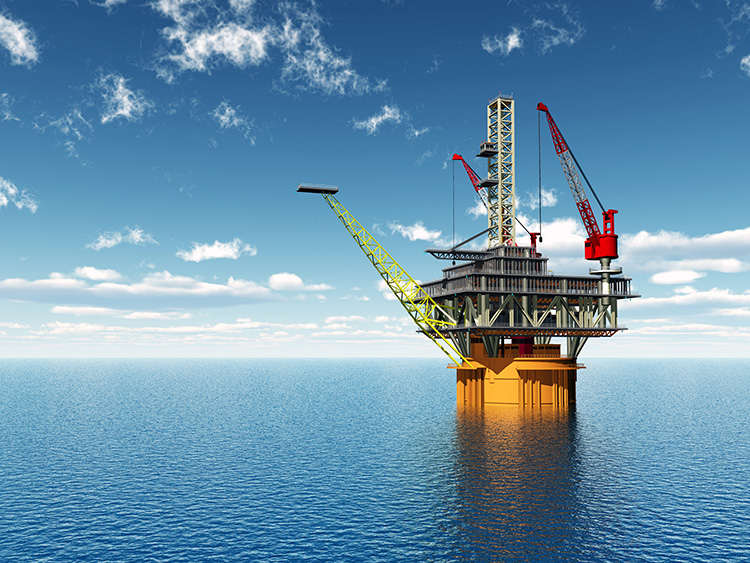By Mahinaz El Baz
Hydrocarbon recovery in deep-water presents a unique challenge to oil and gas operators. Safe drilling operations and protecting the environment are primary requirements, in addition to minimizing risks and maximizing recovery. With average worldwide rig day rates remaining higher than $300,000 – drill ships and semisubmersible rigs -, there is no chance for unexpected costs resulting from nonproductive time, according to Baker Hughes.
Accordingly, developing a deep-water reservoir requires planning and proven dependable expertise to achieve efficient and flawless execution in some of the most difficult formations and complex wells. When savings of millions of dollars can be gained, operators look for solutions that work and the people that can provide them.
Thus, the challenges found in deep-water drilling and recovery operations have, in a remarkable short period, imposed international oil companies (IOCs) to develop new significant technologies and advanced techniques. The geological characteristics of the deep-water environments have pushed design criteria, normally used in onshore and shallow-water wells, to values beyond their traditional limits.
Challenges Facing Deep-water Reservoirs
IOCs are facing new challenges in developing deep-water reservoirs and increasing their productivity. The key challenges involve areas of safety, environment, low permeability, concept design, cost, flow assurance, and equipment reliability, as John Cromb, Senior Deep-water Drilling Engineer at Texaco Worldwide Exploration and Production, stated in his research paper entitled “Managing Deep-water Risk and Challenge”.
Many of the deeper reservoirs tend to have very high pressures and temperatures that exceed the industry’s current ability to produce them. In many cases, the industry lacks production analogues for these reservoirs, which has greatly increased uncertainty in predicting well performance and ultimate recovery, and variables that are fundamental to ensuring the commercial success of a project, according to Richard Souza in his article entitled “Future deep-water developments bring challenges, opportunities”.
High cost is another challenge facing the development of deep-water reservoirs. “As a consequence of escalating complexity and uncertainty of frontier deep-water projects, the industry is struggling to quantify and manage project complexity, capex, and risk required to achieve predictable project outcomes,” Souza noted. An analysis examined a sample of 130 oil and gas mega projects executed from 2003-2015 and concluded that only about 1 out of 5 projects could be reasonably defined as successful -measured by how well sanctioned cost and schedules are met. The rest were unimpressive with average cost and schedule overruns of 30%, he added. It worth noting that most deep-water projects today fall into the mega project category.
Thus, industry experts believe that deep-water completions should maximize ultimate recovery for projects to be economically viable. Newly discovered deep-water reservoirs are capable of high flow rates and the wells must be designed accordingly, added Cromb. In addition, the cost and inaccessibility of deep-water wells require to rely heavily on new innovative techniques and advanced technologies to optimize the capital expenses on projects.
Although new technologies are essential for deep-water reservoirs recovery, there are risks in using technology that has not been strictly tested for reliability. It worth mentioning that reliability problems during the life of a well show up in the form of reentry and workovers, which must be optimized to be able to achieve the project economics. Problems may result in information damage, lost reserves, and safety and environmental exposure, Cromb highlighted.
Maximizing Recovery from Deep-water Reservoirs
Increasing recovery rates from deep-water reservoirs requires a full understanding of the behavior of hydrocarbon mixtures as they move from extremely deep rock formations, through complicated subsea piping systems, to surface facilities. The extreme variations in temperature and pressure along this path can present unique challenges to equipment designers, according to the National Energy Technology Laboratory.
The currently implemented techniques to recover deep-water reservoirs consist of “SPAR Platform and floating production system & offloading (FPSO),” Asser Ammar, Subsurface Manager at Transglobe Energy Corporation, told Egypt Oil & Gas.
In addition to those techniques, groundbreaking deep-water-specific technologies are another way to increase recovery rates. These technologies enable new reserves to be recoverable that were not previously accessible, further maximizing recovery in deeper, more complex, and more remote environments while minimizing nonproductive time without sacrificing safety, quality, or ecological responsibility, according to Halliburton’s research paper on deep-water challenges.
“Subsea processing is one of the most effective technologies used by operators to increase reservoirs recovery. The traditional approach to subsea processing has been the installation of multiphase pumps in close proximity to the wells. Multiphase pumping, or boosting, improves the economics by reducing back-pressure on the reservoirs, increasing flow rates and total recoverable reserves,” according to Oil & Gas Magazine’s article entitled ”Increasing Deep-water Reservoir Recovery with Subsea Boosting Technology”.
Industry experts believe that deep-water is primarily about light oil in high quality reservoirs. “Some heavy or poorer quality oils do exist (e.g. Brazil), yet they are a small part of the current mix. Enhanced oil recovery is not a significant factor even in the shallower regions of offshore. However, as the easier oil is developed over the next few decades, [there is] the potential for the emergence of new technologies to enable the economic development of more difficult hydrocarbons in deep-water regions. This could include not only heavier oils, but wholly unconventional hydrocarbons such as hydrates. However, experts argue that offshore hydrates will remain more costly than less exotic alternatives for the foreseeable future,” the National Petroleum Council Oil&Gas study about deep-water pointed out.
Success Story: the Gulf of Mexico
An empirical research paper entitled “Improve Ultimate Reservoir Recovery from Deepwater Wells in the Gulf of Mexico Using an Emerging Subsea Processing System” presented an emerging subsea processing system that comprises several deep-water wells equipped with electric submersible pumps (ESPs) and one or more seabed booster pumps. This system provides efficient reservoir hydrocarbon recovery by maximizing pressure drawdown at the sand-face. The in-well ESPs increase the pressure drawdown to improve production throughout the life of the reservoir, while the subsea booster pump lifts the combined production from all wells to reach the processing facilities at sea surface. This system integrates several production technologies to optimize performance, lower operating costs and support reliable and safe operation.
The Lower Tertiary trend (LTT) in the Gulf of Mexico (GOM) poses a number of documented challenges for flowing reservoir fluid from the sand-face to surface facility. As most of the deep-water reservoirs, the key challenges are operations, due to low permeability, high pressures, high temperatures, and water and well depths. The empirical research aimed to test the feasibility of the subsea processing system and quantify its production performance for a typical LTT field. Thus, it included development of a full field system layout and simulations of production performance for a range of reservoir and system assumptions. In addition, operational issues, such as system stability, power balancing, and basic control methods, were considered, including the use of transient simulations, to ensure a reliable and efficient operation of the system.
These form the basis of a unified pump control methodology. To verify the impact of in-well ESP reliability on field performance, a comprehensive availability model was developed using reliability data for individual system components; ESP reliability, ESP intervention time, and rig deployment time were varied to determine their impact on overall system availability. The results of the availability model were then combined with the steady-state production results to define production availability and calculate a range of internal rate of return (IRR) values for a typical LTT field development.
Utilization of the system showed enhancement in oil recovery in the range of 20 -50% over use of a seabed boosting pump alone and substantial improvement in total liquid and oil gain as compared to natural lift. The system resulted in very satisfactory IRR and achieved production availability targets by using alternatively deployed ESPs. Moderate improvement in in-well ESP reliability combined with shorter rig mobilization time for intervention shows significant improvement in production availability. In total, the combination of seabed boosting pumps and in-well ESPs should be considered as a viable method of enhancing recovery from challenging deep-water subsea fields such as those of the LTT in GOM.
The unified pump control methodology is the key to safe and reliable operation of the system. The empirical research paper successfully presented an approach on how to operate ESPs safely, by minimizing transient responses and shifting total operating load as much as possible to the seabed pumps, thereby reducing stress on the ESPs. Furthermore, the development of an enhanced production availability model of the system quantifies the production performance for a variety of field scenarios and subsystem behavior.
Deep-water Recovery in Egypt
In Egypt’s prospective deep-water areas, the spectrum of technology available today to understand and optimize the life cycle value of a discovery is especially important, due to the complexity of many of the productive zones, according to Oil&Gas Journal. Using innovative techniques enhances reservoir understanding, and leads to a more accurate estimate of reserves and a better well and reservoir optimization.
Tackling the main challenges facing deep-water reservoir recovery in Egypt, Ammar explained that drilling cost is one of the main challenges, yet it can be reduced by creating realistic field development plan, which leads to the right direction in regards of the best number of wells to be drilled per year. In addition, FDPs, which are translated from business plans, impact the drilling schedule and drilling ships contracts. “Production techniques can be optimized by following opportunity reposition process in which production concept will be optimized and selected out of multiple development techniques, which will affect the entire project,” Ammar added.
When asked about the new technologies in deep-water reservoir recovery, Ammar mentioned that there are many technologies, like multiple fracs horizontal wells. As for Egypt, the used technology in any deep-water reservoir is depending on the IOC’ strategies and agreements with the Egyptian Ministry of Petroleum and Mineral Resources, as once these fields are discovered and brought online, all exploration costs will be on cost recovery.
Omar Azim, an Expert in Reservoir Engineering, highlighted that “the challenges in deep-water drilling are mainly the high cost and bad weather.” As for Egypt, there is a need to pump extra investments in deep-water activities, through acquiring geological and seismic data to encourage foreign partners to drill in such areas. Azim additionally highlighted the importance of collaboration between NOCs and IOCs, as Egypt will not be able to invest in such projects independently, due to the high cost. Egypt needs foreign partners to invest in new technologies and techniques as well, he noted.
Deep-water recovery is changing dramatically in terms of technology, concept design, and the complexity of operations. As a result, the oil and gas industry will be continually challenged to sustain the growth of deep-water operations through increasing the recovery rates. This will urge the need to invest in new technologies and provide innovative solutions to the potential technical challenges.








